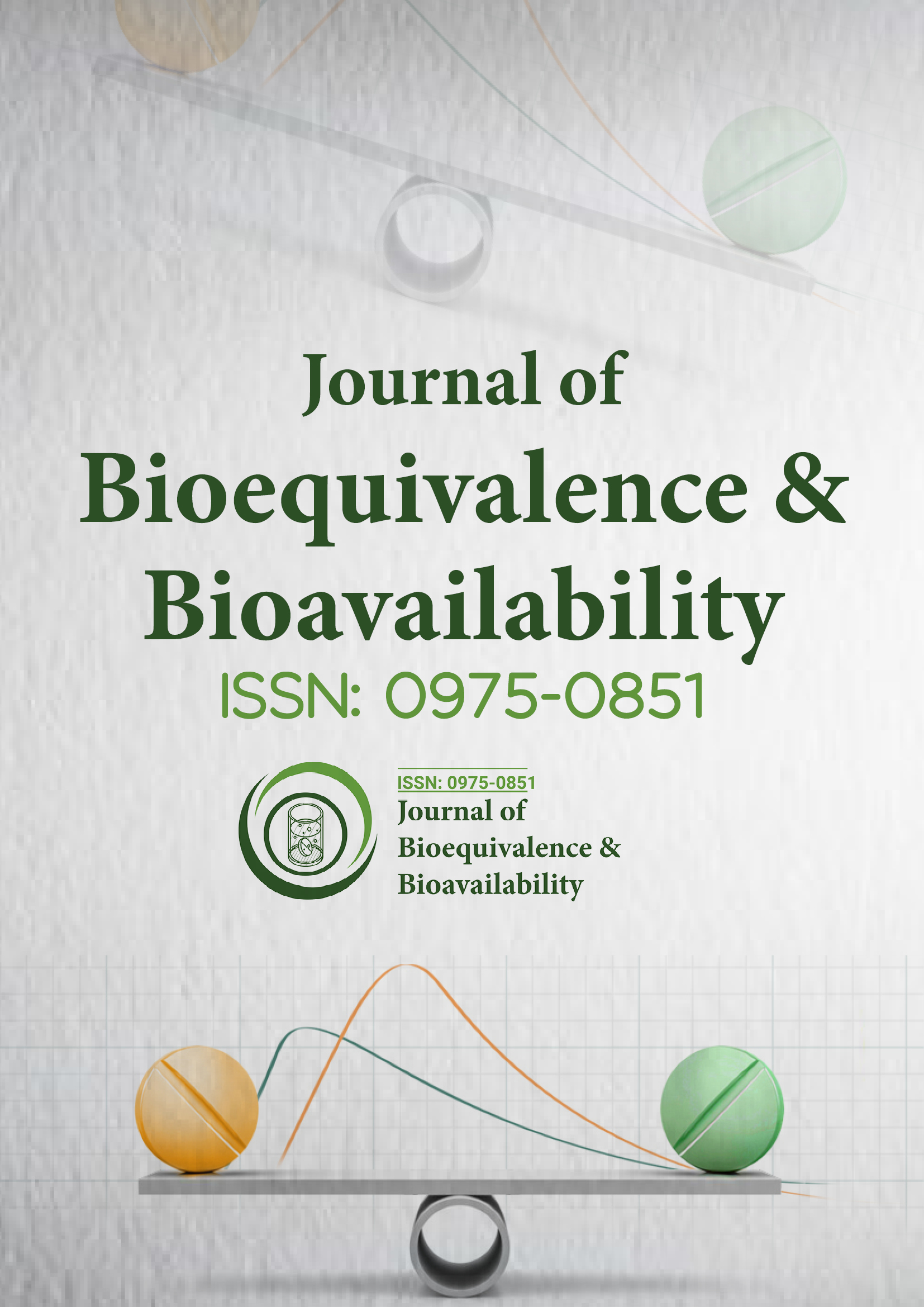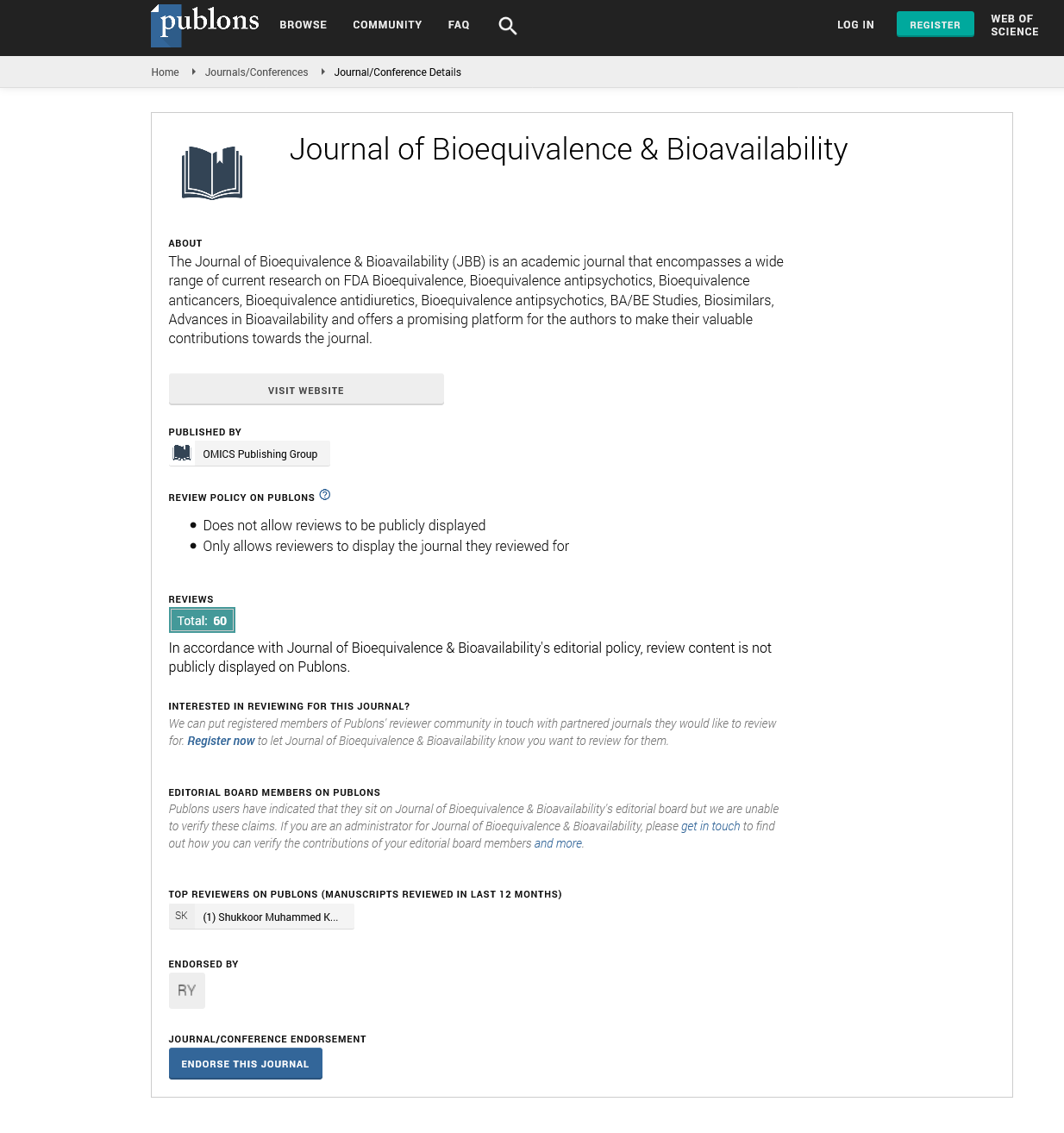Indexed In
- Academic Journals Database
- Open J Gate
- Genamics JournalSeek
- Academic Keys
- JournalTOCs
- China National Knowledge Infrastructure (CNKI)
- CiteFactor
- Scimago
- Ulrich's Periodicals Directory
- Electronic Journals Library
- RefSeek
- Hamdard University
- EBSCO A-Z
- OCLC- WorldCat
- SWB online catalog
- Virtual Library of Biology (vifabio)
- Publons
- MIAR
- University Grants Commission
- Geneva Foundation for Medical Education and Research
- Euro Pub
- Google Scholar
Useful Links
Share This Page
Journal Flyer

Open Access Journals
- Agri and Aquaculture
- Biochemistry
- Bioinformatics & Systems Biology
- Business & Management
- Chemistry
- Clinical Sciences
- Engineering
- Food & Nutrition
- General Science
- Genetics & Molecular Biology
- Immunology & Microbiology
- Medical Sciences
- Neuroscience & Psychology
- Nursing & Health Care
- Pharmaceutical Sciences
Commentary - (2021) Volume 0, Issue 0
Bio Equivalence Study of a Single and Multi Dose Drug
Osita E Onyejekwe*Received: 01-Dec-2021 Published: 22-Dec-2021
Description
The bio equivalence study should be a comparison of a single dose of the drug product to be tested with the appropriate sample material for normal adults. Single-dose research should be different in design, unless the same design or another design is more suitable for valid scientific reasons, and should provide time for drug termination. Unless an alternative is warranted for practical scientific reasons, the duration of drug withdrawal must be at least three times the life span of the active ingredient of the drug or its therapeutic component, or its metabolites, measured in blood or urine; or at least three times half the life of decay of a pharmacological hazardous effect.
Where comparisons of test product and sample items will be based on blood pressure-the time curve, unless the alternative is more appropriate for practical scientific reasons, blood samples should be taken with sufficient frequency to allow for your measurement of both high concentration in the blood of the active ingredient of a drug or its therapeutic component, or it’s metabolites, is measured; and an Area Under the Curve (AUC) total of at least three times the life of an active ingredient of a drug or a therapeutic component, or it’s metabolites, is estimated.
In a study comparing oral dose forms, sample times, the intravenous dosage form and the oral dosage form, sample times should be those required to define both the distribution and subtraction phase of the intravenous dosing form; and the absorption and removal phase of the oral dose form. In studies comparing drug delivery systems other than oral or intravenous dose forms with the appropriate sample level, sampling times should be based on valid scientific reasons. Where comparisons of test product and sample items will be based on urine excretion time, unless the alternative is more appropriate for practical scientific reasons, urine samples should be collected in sufficient quantities to allow for urine measurement. The rate of urination of an active ingredient of a drug or part of a treatment, or its metabolites is estimated.
Where comparisons of test product and sample items will be based on the timing of the treatment effect, estimates of this effect should be made with sufficient frequency to allow a reasonable estimate of the total AUC time period at least three times. Half-life of the pharmacological effect of decay, unless the alternative is more appropriate for valid scientific reasons. The use of a pharmacological risk factor is to determine bio availability may require dose-related response. In such a case, the bio availability may be determined by comparing the doseresponse curves with the total area under the pharmacological risk factor-time curves of any given dose. Multi-Dosage Research Guidelines in selected cases, may be necessary to test the product and sample items after repeated administration to determine the stable levels of the active ingredient of the drug or component in the body. Test product and sample materials should be provided in studies in the form of fasting or fasting, depending on the conditions indicated in the proposed writing of the test product. Multi-dose research may be required to determine the bio availability of the product of the drug in the following cases where there is a difference in absorption rate but not in adsorption rate, there is a significant variation in bio availability from one dose to another; the concentration of the active ingredient of a drug or its therapeutic component, or its (metabolites), in a single volume is too low for accurate analysis; drug product is a form of extended release dose.
Conclusion
Multi-dose research should differ from formulation, unless the same design or other design is more appropriate for valid scientific reasons, and should provide time for drug overdose if stabilization conditions are not met. If duration of drug withdrawal is required, unless the alternative is particularly appropriate for practical scientific reasons, the duration of drug withdrawal should be at least five times the life of the active ingredient of the drug or part of the treatment, or active metabolites), measured in blood or urine; or at least five times in the half-life of the pharmacological risk factor.
Citation: Onyejekwe OE (2021) Bio Equivalence Study of a Single and Multi Dose Drug. J Bioequiv Availab. S6:001.
Copyright: © 2021 Onyejekwe OE. This is an open-access article distributed under the terms of the Creative Commons Attribution License, which permits unrestricted use, distribution, and reproduction in any medium, provided the original author and source are credited.

